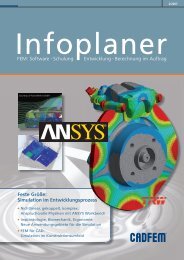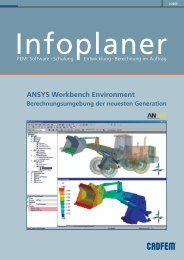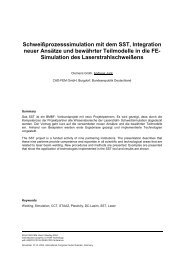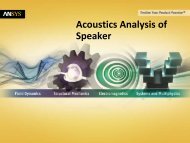FEM: Software • Schulung Entwicklung • Berechnung ... - CADFEM.CH
FEM: Software • Schulung Entwicklung • Berechnung ... - CADFEM.CH
FEM: Software • Schulung Entwicklung • Berechnung ... - CADFEM.CH
Erfolgreiche ePaper selbst erstellen
Machen Sie aus Ihren PDF Publikationen ein blätterbares Flipbook mit unserer einzigartigen Google optimierten e-Paper Software.
28<br />
Heavy Machinery:<br />
Simulation and Shared Engineering at Siempelkamp Group<br />
The Siempelkamp Group is an international supplier of<br />
equipment covering diverse market segments of industry.<br />
The roots of the company, founded in 1883 and still a<br />
family-owned business, are in the design and manufacture<br />
of machinery, plant design, and foundry technology. Today,<br />
the fi ve business units are Machinery and Plants, Industrial<br />
Automation, Nuclear Technology, Foundry, and Metal Forming.<br />
As a global player with approximately 2,500 employees,<br />
Siempelkamp generates an annual turnover of over<br />
500M Euros (2004).<br />
It all started in 1883, with the invention of the perforated<br />
heating platen for textile presses on which Gerhard Siempelkamp<br />
founded his company, focusing on the development of<br />
complete presses. Even during the early years, the company’s<br />
aim was to supply not just a product to its customers, but a<br />
solution to their problems, too. This was achieved by offering<br />
additional engineering services and combining mechanical<br />
and process engineering.<br />
In the 1980s and 1990s, plants became increasingly more<br />
complex and were automated using modern data processing<br />
technology and software systems for process optimization<br />
and production management.<br />
Approximately 60 design engineers work at the Siempelkamp<br />
Group’s Krefeld site, developing new applications and<br />
machines. Ten of these engineers apply different simulation<br />
software tools, such as ANSYS Mechanical, ANSYS Professional,<br />
and ANSYS DesignModeler.<br />
In 1995, Siempelkamp decided to use the ANSYS program<br />
for Finite Element Analyses (FEA). Owing to a growing<br />
demand for solving problems and performing analyses to<br />
produce reliable machines, the number of engineers using<br />
FEA increased from 4 to 10. Most of the FEA users’ work<br />
involves investigating the linear elastic behaviour of complex<br />
structures and components. Thermal problems are another<br />
important application area.<br />
A recent challenge in the fi eld of FEA was the analysis of<br />
both all components and the entire frame of a 12-daylight<br />
press (Fig. 1) designed for the production of wooden panels<br />
with a size of almost 4 x 11 meters.<br />
Eight hydraulic press cylinders, each with a piston diameter<br />
of over a meter, provide a pressing force of 210.00 kN.<br />
The press is designed as an upstroke press, and its frame is<br />
formed of several elements. The individual lateral stands are<br />
connected to the upper and lower crossbeams, thus forming<br />
the press frame. The elements are not welded but, in order<br />
Case Studies<br />
CAD<strong>FEM</strong> GmbH INFOPLANER 2/2005<br />
Fig. 1: View of the<br />
12-daylight press<br />
A: Upper press table<br />
B: Lateral stands<br />
C: Heating platens<br />
D: Closing mechanism<br />
E: Lower press table<br />
F: Frame beams<br />
G: Man<br />
to achieve greater fatigue strength, assembled and fastened<br />
using bolts instead.<br />
Considering that each press table is an enormous 4 m x 11<br />
m in size, 1.8 m thick and (unfi nished) weighs 215 tons, the<br />
entire Siempelkamp know-how and the synergies within the<br />
Siempelkamp Group can be observed in the production of<br />
heavy castings such as upper and lower press tables. This<br />
kind of work is naturally carried out by the Siempelkamp<br />
Foundry Branch, Krefeld.<br />
The casting takes 3 weeks to cool suffi ciently to enable their<br />
removal from the molds. They are then transported on a special<br />
truck to the adjacent Siempelkamp Machinery Branch,<br />
where they are subjected to the fi nal stages of treatment.<br />
Heating platens for the presses are also manufactured in the<br />
Krefeld factory. To this end, two plates with a thickness of<br />
200 mm are joined by means of SAW (submerged-arc welding)<br />
to form a 4.1 x 10.73 m platen. At this stage, the platen







